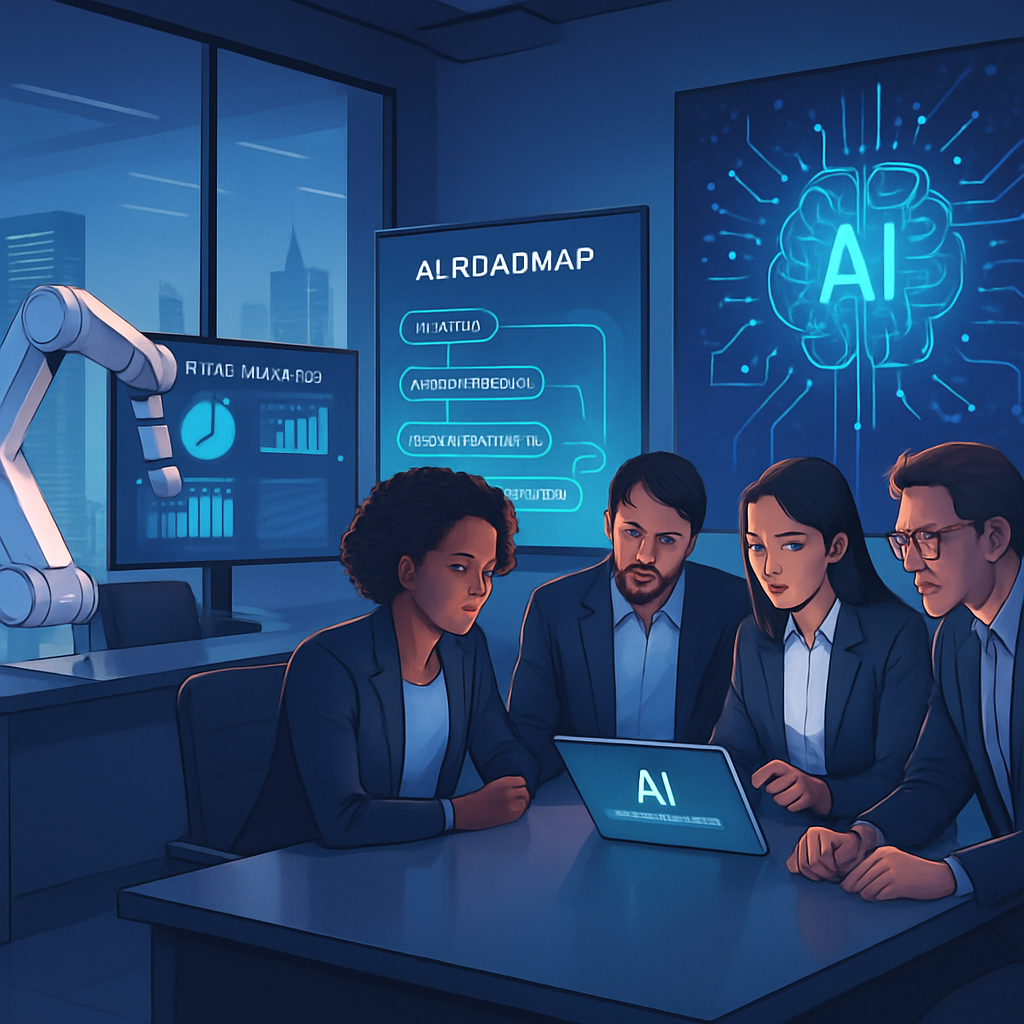Beyond the Algorithm: The Three Pillars of True AI Enablement
In the current wave of technological enthusiasm, it is easy to mistake "Artificial Intelligence" for a product you can buy. Many organizations are rushing to acquire the latest large language model or deploy a new chatbot, believing this alone constitutes an "AI strategy." This approach, however, often leads to stalled projects, wasted investment, and deep organizational friction. They have bought the tool, but they haven't built the capability.
True AI Enablement is not the deployment of a single algorithm; it is the holistic transformation of an organization to systematically leverage data, models, and automation to achieve its core objectives. This enablement rests on three foundational, interdependent pillars: Human Readiness, Technology Readiness, and Process Readiness. Neglecting any one of these pillars is like trying to balance a three-legged stool with only two legs... the entire structure will collapse.

The Human Pillar: Readiness for Change
The most sophisticated AI system in the world is useless if people refuse to use it, do not trust it, or actively work around it. The human pillar is often the most complex and critical element of AI enablement. It is fundamentally an exercise in change management, trust, and upskilling.
This readiness begins with culture. It requires fostering an environment of psychological safety and curiosity, where employees are encouraged to experiment with new tools rather than fear them as replacements. Leadership must clearly articulate the "why" behind AI adoption... framing it not as a tool for cost-cutting, but as a "copilot" for augmentation, designed to free humans from repetitive toil to focus on higher-value strategic work.
From this cultural foundation, we build the necessary skills. This is not just technical training for a few data scientists. It is about creating broad AI literacy across the entire workforce. A powerful, real-world example of this is the strategic rollout of Microsoft 365 Copilot. Organizations seeing the highest adoption and ROI are not those that simply "turn it on" for everyone. Instead, they begin by launching a "Copilot Champions" program.
This program identifies a cohort of engaged employees from various business units... finance, legal, marketing, and operations. This group receives early access and targeted training, but more importantly, they are tasked with a specific mission: to discover and document high-value, role-specific use cases. The finance champion might build a playbook for using Copilot in Excel to accelerate variance analysis, while the legal champion uses Copilot in Word to "ask questions" of a 100-page contract and draft a risk summary in seconds.
These champions then become the evangelists. They demonstrate a tangible "what's in it for me" to their peers, armed with practical, proven examples, not abstract theory. This approach builds trust, flattens the learning curve, and drives adoption organically by proving AI's value as an augmentative "copilot," not a replacement, reinforced by transparent, ethical guidelines and clear "human-in-the-loop" oversight for critical decisions.
Read more about People Readiness in the world of AI...
The Technology Pillar: The Platform for Intelligence
While AI is more than just tech, the technology must be robust, secure, and prepared. The Technology Pillar is the engine of AI enablement, and it runs on three core components: data, systems, and security.
The Data Foundation
The data foundation is paramount. AI models are only as good as the data they are "grounded" on, and most organizations are sitting on a disorganized, siloed "data swamp." Readiness here means having a coherent data strategy, which often requires a modern data platform like Microsoft Fabric. Fabric acts as the "data engineering" hub, providing the pipelines and a unified data lakehouse (OneLake) to transform raw, chaotic data from multiple sources into a clean, structured, and "AI-ready" asset.
This data strategy must also address two types of knowledge:
-
Unstructured Data: This is the human-generated knowledge locked in your SharePoint sites, OneDrive files, and Teams chats. For a tool like Microsoft 365 Copilot, this is its primary source for Retrieval-Augmented Generation (RAG). Readiness here means good information hygiene... if your SharePoint is a mess, your Copilot's answers will be too.
-
Structured & Vector Data: For custom AI applications, you need a high-performance database. This is where a service like Azure Cosmos DB becomes critical. It can store and perform ultra-fast "vector searches" on your data, allowing a custom-built AI agent to find the conceptual meaning behind a user's query, not just a keyword match.
Systems and Architecture
Modern AI, particularly generative AI, is compute-intensive and thrives on scalable, flexible infrastructure. This readiness almost always means a mature cloud posture. Monolithic, on-premise systems lack the elasticity and access to cutting-edge tools that cloud platforms provide.
This is where a platform like Azure AI Foundry (or even low-code solutions such as Microsoft Copilot Studio) becomes the central "factory" for developing custom, proprietary AI solutions. An organization might want to build a custom AI agent to analyze supply chain disruption data... a task far too specific for a general-purpose copilot. Using Azure AI Foundry, they can assemble all the necessary components in a single, governed environment. They can select from a catalog of foundation models, securely ground that model on their own data (using Azure AI Search and RAG), and deploy the resulting agent as a secure API. This platform provides the end-to-end "ModelOps" required for building, training, and managing enterprise-grade AI applications.
Security and Governance
Finally, security must be woven into the fabric of the platform. This is not a theoretical exercise. Consider the challenge of rolling out Microsoft 365 Copilot, which connects powerful LLMs to your entire universe of internal data. The single greatest barrier to this is the fear of "data oversharing," where an employee's broad query could surface a sensitive file they shouldn't see, like a draft of a new org chart.
This is precisely why a tool like Microsoft Purview Data Security and Privacy Management (DSPM) becomes a non-negotiable prerequisite. Before you can safely "unleash" AI, you must know where your crown jewels are. DSPM provides a dynamic, real-time map of your data estate, discovering where sensitive data lives, who has access to it, and how it's flowing. This "data security posture" intelligence allows you to find and remediate risks (like over-permissioned SharePoint sites) before you enable AI, ensuring that when Copilot retrieves data, it respects the strong data governance and "need-to-know" boundaries you have already established.
Continue reading about AI enablement and managed delivery here...
The Process Pillar: The Strategy for ROI
The final pillar connects the people and the technology to tangible business value. It answers the critical questions: "Where do we start?" and "How do we ensure this creates a return on investment (ROI)?" This is where AI moves from a science experiment to a business strategy.
This begins with process intelligence. Before you can "enable" a process with AI, you must move from "what we think we do" to "what we actually do." Many organizations believe their "order-to-cash" process is a clean, linear workflow. The reality, revealed by system logs, is often a complex web of manual rework, exceptions, and bottlenecks.
This is where Process Mining capabilities, such as those within Microsoft Power Automate, provide the essential "x-ray." By analyzing the event logs from your ERP or CRM systems, process mining tools visually map the real end-to-end process. You might discover that 40% of all invoices are "stuck" for 10 days awaiting manual approval from a specific manager. This data-driven insight is the key to strategic prioritization. Instead of a vague "let's use AI to improve billing" project, you can now target a specific, high-ROI problem with a solution like a Power Automate flow that uses AI Builder to intelligently route those specific invoices.
With this map, you can apply strategic prioritization to find the intersection of high business value and high feasibility. Look for tasks that are repetitive, rule-based, or data-intensive. Automating these "quick wins" delivers measurable ROI, builds organizational momentum, and funds the next, more ambitious AI initiatives.
Continue reading about process discovery and optimization for AI enablement.
Conclusion: From Doing AI to Being AI-Enabled
AI Enablement is not a destination; it is a continuous journey of building organizational capability. It is the disciplined work of preparing your people for a new way of working, engineering your technology platform for a new kind of workload, and aligning your processes to a new source of value.
By focusing on all three pillars (Human, Technology, and Process) an organization can move beyond simply doing AI projects and truly become an AI-enabled enterprise: more intelligent, more efficient, and more resilient.
Stay connected. Join the Infused Innovations email list!
Share this
You May Also Like
These Related Posts

From Potential to Production: A Strategic Guide to Building Enterprise-Ready Agents on Azure

Artificial Intelligence in Higher Education: The Current State

No Comments Yet
Let us know what you think